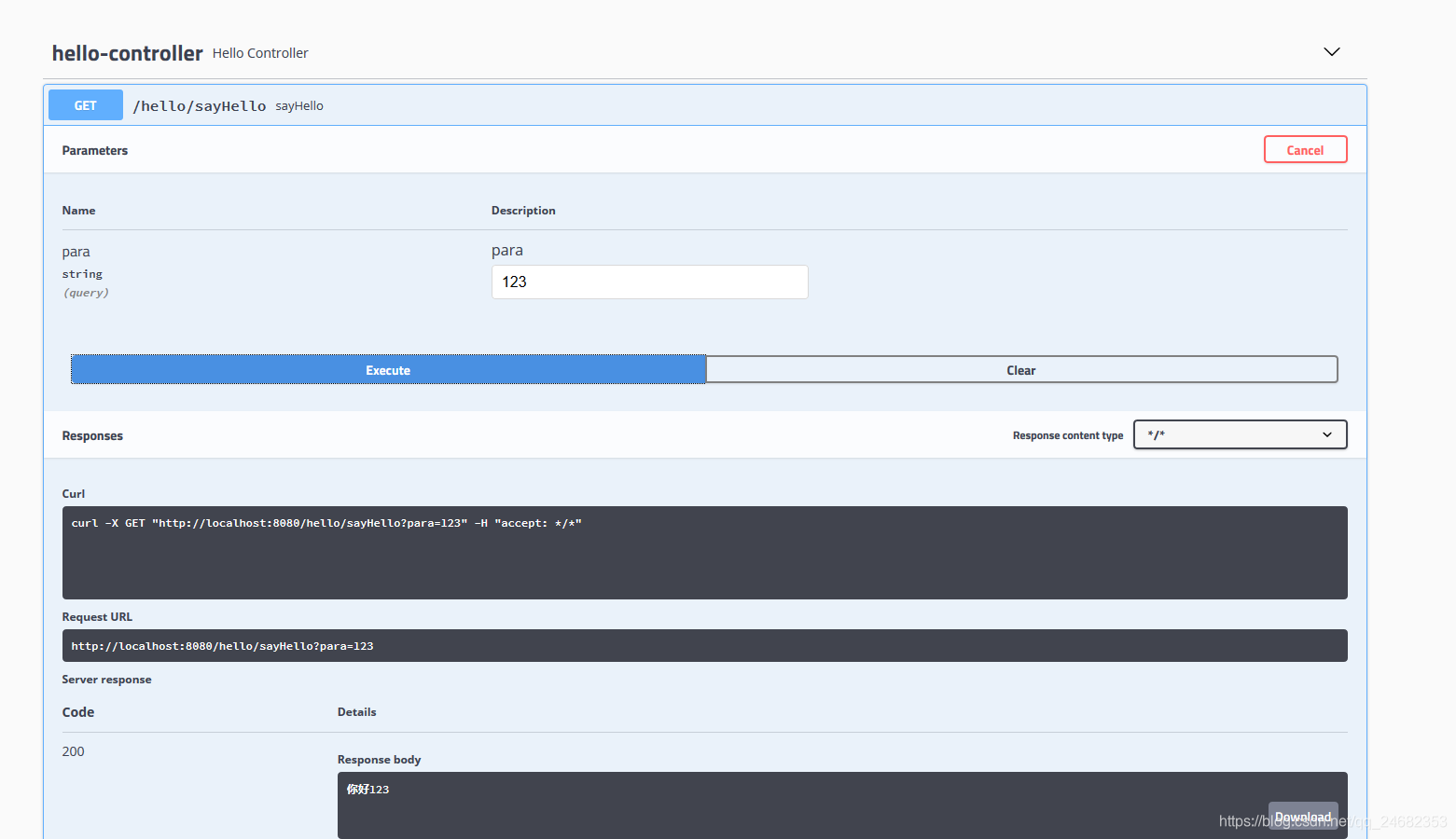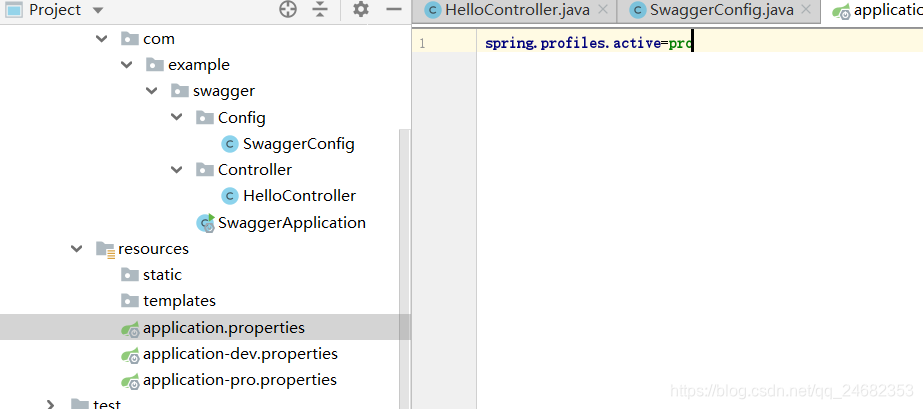Swagger的使用
1.首先引入swagger,对应maven坐标
<dependency>
<groupId>io.springfox</groupId>
<artifactId>springfox-swagger-ui</artifactId>
<version>2.9.2</version>
</dependency>
<dependency>
<groupId>io.springfox</groupId>
<artifactId>springfox-swagger2</artifactId>
<version>2.9.2</version>
</dependency>
2.启动swagger配置
注:我使用的使springboot
1.新建swagger配置类,在类上添加注解@Configuration和@EnableSwagger2
@Configuration
@EnableSwagger2
public class SwaggerConfig {
}
3.添加controlle方法
@RestController
@RequestMapping("/hello")
public class HelloController {
@RequestMapping("/sayHello")
public String sayHello(String para){
return "你好"+para;
}
}
4.启动服务
1.访问http://localhost:8080/swagger-ui.html
 可以查看当前swagger支持的http方法.
可以查看当前swagger支持的http方法.
 如果controller有参数的数他会显示出来,填写参数之后,单击execute执行即可看到返回结果.
如果controller有参数的数他会显示出来,填写参数之后,单击execute执行即可看到返回结果.
5.根据当前开发版本选择是否开启swagger
@Configuration
@EnableSwagger2
public class SwaggerConfig {
@Bean
public Docket docket(Environment environment){
Profiles profiles = Profiles.of("dev");
boolean flag = environment.acceptsProfiles(profiles);
//获取项目的生产环境
return new Docket(DocumentationType.SWAGGER_2)
.apiInfo(apiInfo())
.enable(flag)
.select()
.build();
}
private ApiInfo apiInfo(){
Contact contact = new Contact("","","");
return new ApiInfo(
"凉白开的日志",
"凉白开的文档信息",
"1.0",
"",
contact.toString(),
"",
""
);
}
}
当前项目结构
 他可以根据spring.profiles.active=pro判断当前开发环境进行判断是否启用swagger
他可以根据spring.profiles.active=pro判断当前开发环境进行判断是否启用swagger
6.如果一个项目的接口太多,多大几百上千个怎么办?
这种情况下可以使用groupName("第一个文档")进行分组显示,
@Configuration
@EnableSwagger2
public class SwaggerConfig {
@Bean
public Docket docket(Environment environment){
Profiles profiles = Profiles.of("dev");
boolean flag = environment.acceptsProfiles(profiles);
//获取项目的生产环境
return new Docket(DocumentationType.SWAGGER_2)
.apiInfo(apiInfo())
.enable(flag)
.groupName("第一个文档")
.select()
.apis(RequestHandlerSelectors.basePackage("com.example.swagger.Controller"))
.build();
}
@Bean
public Docket docket2(Environment environment){
Profiles profiles = Profiles.of("dev");
boolean flag = environment.acceptsProfiles(profiles);
//获取项目的生产环境
return new Docket(DocumentationType.SWAGGER_2)
.apiInfo(apiInfo())
.enable(flag)
.groupName("第二个文档")
.select()
.apis(RequestHandlerSelectors.basePackage("com.example.swagger.controller2"))
.build();
}
private ApiInfo apiInfo(){
Contact contact = new Contact("","","");
return new ApiInfo(
"凉白开的日志",
"凉白开的文档信息",
"1.0",
"",
contact.toString(),
"",
""
);
}
}
最终效果图


7.swagger注解使用
1.实体对象上的注解的使用
注:只有当controller的返回实例中有该module的时候,才会在swagger中显示出来,
module一定要实现getset方法
@ApiModel("用户实体类")
public class User {
@ApiModelProperty("用户名称")
private String name;
@ApiModelProperty("用户密码")
private String password;
public String getName() {
return name;
}
public void setName(String name) {
this.name = name;
}
public String getPassword() {
return password;
}
public void setPassword(String password) {
this.password = password;
}
}
2.注解在controller中的使用
@RestController
@RequestMapping("/hello2")
@Api(tags = "啊哈哈哈",value = "就是就是")
public class HelloController {
@GetMapping("/2sayHello/{para}/{para2}")
@ApiOperation("123")
@ApiImplicitParams({
@ApiImplicitParam(name="para",value="打招呼",required=true,paramType="path"),
@ApiImplicitParam(name="para2",value="打招呼2",required=true,paramType="path")
})
public String sayHello(@PathVariable String para,@PathVariable String para2){
return "你好"+para;
}
}
注解说明:@Api中的value是没有任何效果的,只有tag有值如下图 @ApiImplicitParams中的ApiImplicitParam和ApiParam作用是相同的,这里推荐使用ApiImplicitParams,这里对paramType说明:
@ApiImplicitParams中的ApiImplicitParam和ApiParam作用是相同的,这里推荐使用ApiImplicitParams,这里对paramType说明:
header–>放在请求头。请求参数的获取:@RequestHeader(代码中接收注解)
query–>用于get请求的参数拼接。请求参数的获取:@RequestParam(代码中接收注解)
path(用于restful接口)–>请求参数的获取:@PathVariable(代码中接收注解)
body–>放在请求体。请求参数的获取:@RequestBody(代码中接收注解)
form(不常用)
paramType如何接口使用resuful接口,但是paramType写成query,这种情况下,swager在前端他会这样进行拼接 XXX/{para}/{para1}?para=1¶=2,所以paramType一定要写正确
@ApiOperation(“123”) 说明当前接口是干什么的
@Api(tags = “啊哈哈哈”,value = “就是就是”)说明当前类事干什么的
如果有其他的问题之后再补充哈,





 本文介绍了Swagger2的入门步骤,包括引入依赖、配置启动、添加控制器方法,以及如何在不同开发环境中启用。针对大量接口的情况,文章提供了解决方案,并详细讲解了Swagger注解的使用,如@Api、@ApiOperation、@ApiImplicitParams等,强调了paramType的正确选择对RESTful接口的重要性。
本文介绍了Swagger2的入门步骤,包括引入依赖、配置启动、添加控制器方法,以及如何在不同开发环境中启用。针对大量接口的情况,文章提供了解决方案,并详细讲解了Swagger注解的使用,如@Api、@ApiOperation、@ApiImplicitParams等,强调了paramType的正确选择对RESTful接口的重要性。
















 5950
5950

 被折叠的 条评论
为什么被折叠?
被折叠的 条评论
为什么被折叠?








